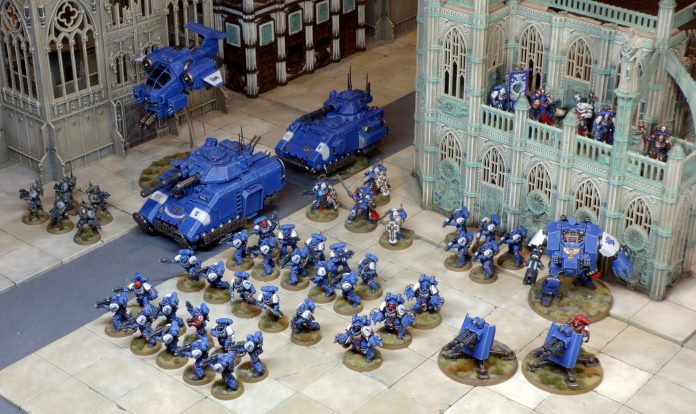Finishing your own army is core to the Warhammer 40,000 hobby. In our Army Showcase series, Goonhammer contributors take a look at the armies we’ve been collecting for years, and the new ones we’ve just finished – what drew us to them, why we keep building and painting, and how they play on the table. This week, Charlie’s here to bounce into the deep end of a narrative army… an army that stubbornly employs an assortment of off-meta units that have no hope of surviving tournament tables.
The painter: Charlie Brassley
The army: Cobalt Scions (Primaris Ultramarines Successors)
Points: just over 2.5k
Collected: since July 2019
Instagram: @charliebrassley
Amidst the blood and skulls and dystopian horror, I am forever charmed that Guilliman’s boys find the time for questions like “have we got enough supply trucks?” and “is this commercial concourse efficiently laid out?”
Unfortunately, with all the poster boy treatment, you can lose a lot of this comedy potential. You can also lose some of the fun character flaws, and you see, here’s the charm of making up a successor chapter: I can collect the Ultramarines as I’d like them to be. There are so many ways to draw on Greco-Roman roots besides being well organised and regimented; there’s the mishmash of cultures, the over-ambitiousness, the engineering ingenuity, the vanity, the superstition, the politicking, and the arrogance too.
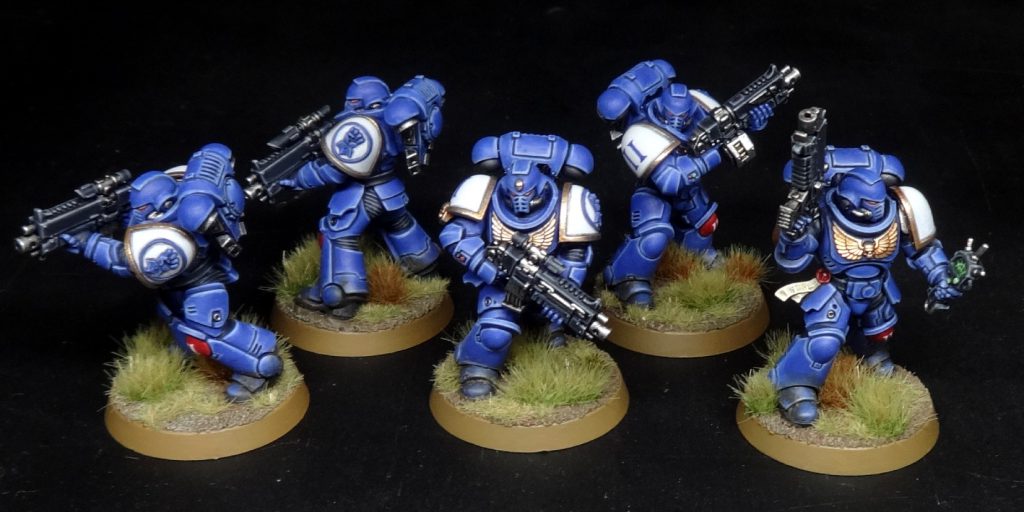
OK, but why Ultramarines as a starting point for your successor chapter?
My child brain imprinted on the 1993 Ultramarines Captain model; the mashup of Greco-Roman and space dude was immediately charming. I’ve bounced around a number of factions during my decades in the hobby, but I’ve always retained a soft spot for them.
In particular, I love their grognardy appreciation of logistics and infrastructure. It makes them feel like the adults in the room, ready to do boring but important stuff while the kids kill, maim and burn their way across the galaxy. 40K leans exhaustingly hard into nihilism on occasion, so the fact that Guilliman’s lads build as well as destroy offers something to fight for, even if that something is a nightmarish regime that offers no hope or joy. Ahhh, 40K. My point is, they have a plan beyond ANGRY MAN BREAK STUFF.
I also love them because blue and gold go together like Boris Johnson and clown cannons.
The plan was to do about a thousand points, and paint them nicely. The sort of methods one shouldn’t try and sustain for a full army, but which will look nice in the cabinet. Then, I figured, I’d move on to something else.
That’s not quite how it went.
Why I kept going past 1k, and then past 2k
After the fast and dirty paint jobs I’d been throwing at my Imperial Guard and Orks for years, highlighting this bright blue was just so satisfying. It pushed me to go the extra mile. This in turn resulted in people at home and on the internet saying nice things about the resulting paint jobs, and the whole thing turned into a positive feedback loop made of smurfs.
By the time I hit 1K, I was really enjoying figuring out their lore. If you like making stuff up, a custom chapter of Astartes gives you a LOT to do. Customs, tactics, demeanour, characters, history… I’d become crazy invested, drawing up maps of their home system and adding entries into our gaming group’s lore wiki. Happily, having like-minded friends means I am not alone in my fondness for taking the narrative side of things A Bit Far.
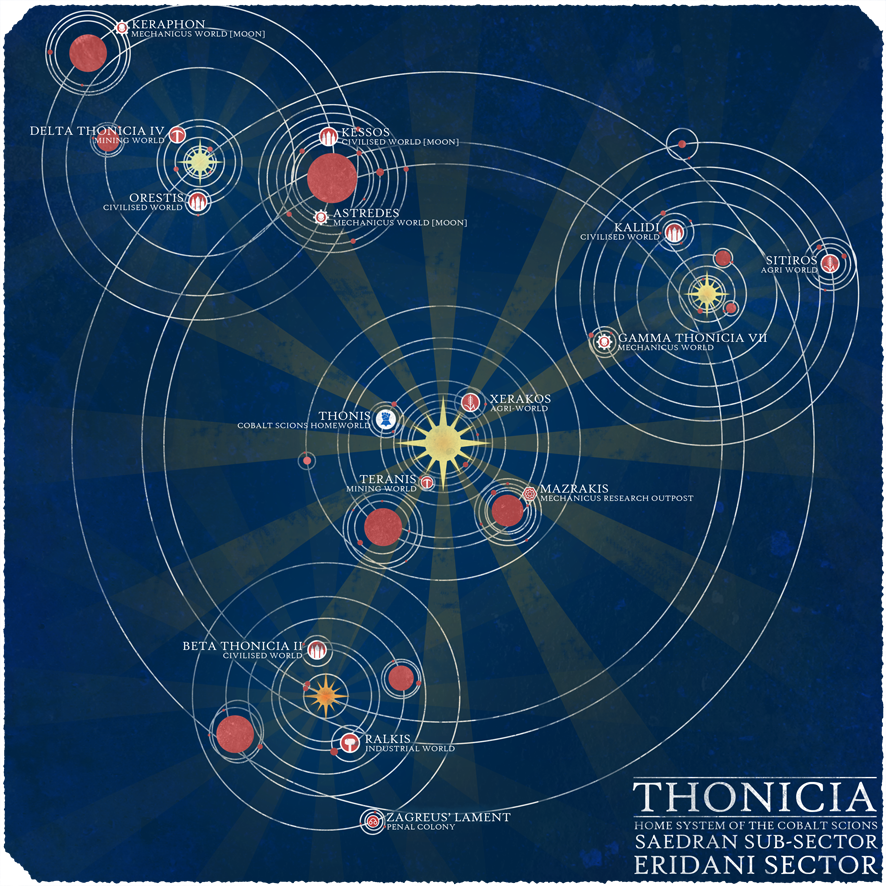
As the project grew, working so consistently on the same thing also – surprise! – helped refine my methods of edge highlighting, getting both crisper and faster by doing things in a rather counterintuitive order.
Beyond enjoying the painting and the lore, I like their play style. The Cobalt Scions’ battle pile adds a surprising amount of nuance in the movement phase if you’re going to get maximal synergy, and they roll slowly up the board like a Greek phalanx.
How they play
The army uses the Inheritors of the Primarch Successor Tactic, making them very much store-brand Ultramarines.
I’ve tried to echo this with an all-rounder force built around a solid core of Intercessors. They’re all about walking steadily towards the enemy while laying down massed bolter fire in a roaming battle pile. Of course, there’ll be a few lone units off grabbing objectives and so on. It’s a conscious choice to sacrifice a fair bit of board control so that I can have the classic codex cover image of a knot of marines clustered around their command squad/banner/corpse pile (depending on how the battle’s going).
To double down on the Greek phalanx and the Roman testudo, I’ve given Captain Lucullus the Nobility Made Manifest warlord trait. This means anyone who charges the battle pile finds that almost every unit in said pile can heroically intervene. If someone wants a fight, they’re getting a big one.
Of course this gives me the enjoyably non-trivial challenge of getting a significant number of units within aura range, such that they all have lines of sight and can effectively intervene. Assuming the terrain doesn’t preclude this (and it often will) it’s mostly accomplished by having formations that intersperse multiple squads, as shown below:

As you can see, the tightest fit is the apothecary’s 3″ aura – the other characters all have a 6″ range with their abilities, which is considerably more forgiving. Note, also, that I don’t deploy the whole command squad unless it’s a big game; that’s a lot of points to blow on characters.
History sidebar: this has the added advantage of referencing one of the theories of how Roman infantry rotated men in and out of fights so that the dudes in the front rank didn’t collapse from exhaustion. They can’t figure out if they did this within units, or by shuffling whole units around. I’m not a historian, so will avoid weighing in on the subject.
A thematic stratagem that ties into the battle pile is Defensive Focus, which enables up to three units within 6″ of the target of a charge to fire overwatch. This is a lot of dice rolling for my poor opponent to sit through, all to get a fairly mediocre damage output, so I only use it in those instances where I think it could make a vital difference. And on occasion, it really has.
The net result is a slow, easily outmanoeuvred army that nonetheless gives my regular opponents pause for thought. You might be asking how that could be remotely possible unless my regular opponents are idiots; Goonhammer’s own Artist-in-Chief TheChirurgeon recently said of the faction he was forced to play with after losing a bet: “Overall, Ultramarines sucked shit to play – they’re wildly underpowered as a faction and unable to deal with many of the game’s major threats.”
But here’s the thing: tournament gaming is almost unrecognisably different to narrative play. It’s not just about optimised army lists; a narrative player is trying to make good tactical choices within the voluntary constraint of playing thematic lists in immersive ways.
So would it get work done in a tournament? No, of course not. That ain’t my hobby. My gaming group is far more into Crusade. I can’t even say that this army would work well in another narrative gaming group; each nerd ecosystem is, after all, its own thing.

How to paint them
The main take-home from painting this many lovingly highlighted marines is that efficiency is improved by doing things in a counterintuitive order. (I am reliably informed you COULD improve efficiency by not highlighting the whole-ass army like a masochist, but I am both an idiot and an edging enthusiast, so here we are.)
The classic Citadel methodology for edge highlighting is basecoat > shade > highlight. The thing is, painting goes faster when you’re allowed to start off with fast, messy stages and gradually get neater as you go on to the next phase.
The Cliff’sNotes version of my power armour painting method is this:
- Zenithal spray the model with marine’s main armour colour. I used a rattle can because I am lazy.
- Do a thicc highlight. Be messy and dreadful. Don’t worry if it slips into the recesses.
- Paint everything else to completion, and don’t worry about getting paint on the main armour since right now it looks so bad your mum wouldn’t stick it to the fridge.
- Do a sharper, brighter highlight on the armour. Again, don’t worry about slipping into the recesses.
- Line in the recesses. Your mini will now look less like ass, but you’re still in wonky donkey territory.
- Do the basecoat! At the end! Make it nice and thin, and use this moment to tighten all your highlights by effectively using the basecoat as an eraser. You were going to have to tidy up anyway, and this way, you only have to do it once. Bear in mind the initial zenithal spray already punted you within a mile of the right colour. Because this stage is done with thinned paint, this has the effect of further softening your highlights since you can subliminally see the brighter, messier stages beneath.
If you’d like a more in-depth run down of the paints I used, and the highlighting method, these two articles will be of use:
- The complete paint recipe (plus a whole load of lore and shots of my captain)
- Blue armour highlighting step-by-step
Lore
As I got deeper into the rabbit hole with this army, I named every unit leader – often painting their names on their pauldrons – and wrote them a personality. I then jumped the shark completely and wrote a whole short story to explain how Sergeant Oreas Cassander came to have a thunder hammer.
It would seem a bit much to include all of that in this post. I’m really rather proud of the lore I’ve written for this chapter, but reading a stranger’s homebrew fluff is, let’s face it, something most people don’t do. I’ll provide the brief version below, and in case you’re the same kind of crazy as me, I’ll provide links to where you can get the full fat edition.
Cobalt Scions lore overview
During the Indomitus Founding, one of the concerns with Primaris marines was their lack of real world experience. For one as-yet unnamed Ultramarines successor chapter, an experiment was proposed: use Ultramarines veterans to lead them. Sergeant Aelius Justarian and his squad stepped up, suggesting that they were already a tight-knit group of ten brothers who could each serve as a company captain.
Sadly, crossing the Rubicon Primaris went… poorly. Justarian and five of his brothers did not survive, leaving a grief-stricken quartet to lead the new chapter without their charismatic sergeant or the wisdom of their squamates. Despite their concern that they might not prove worthy of the challenge, the First Four – Drusus, Tarentian, Fabian and Lucullus – did their best to shape the chapter’s culture, doctrine and heraldry, and named them the Cobalt Scions.
They instilled a belief in adaptability, and high-minded ideas like protecting the populace to inspire loyalty. They place a lot of stock in the power of oratory, and expect that a brother of the chapter should be able to communicate well with the wider Imperium. Unfortunately, they also think it’s a good idea to meddle in politics. Though they’d never brazenly admit it in public–not yet, anyway–they’d love to recreate the glory of Ultramar in their own corner of the galaxy. What could possibly go wrong?
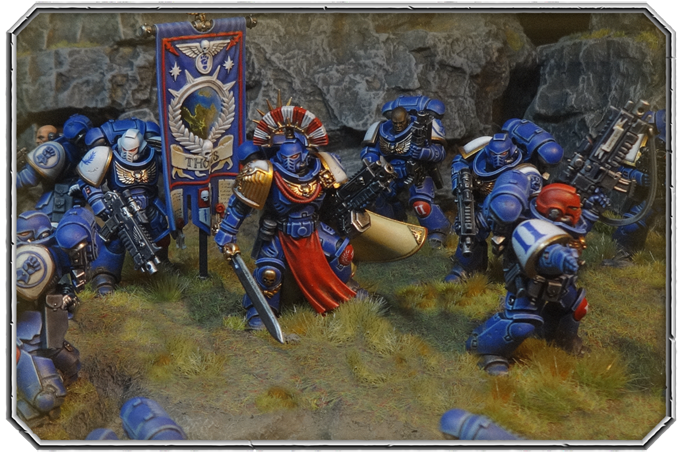
In battle, the Cobalt Scions endeavour to operate much like their gene-sires. Strategically, their greatest strength is logistics. This is achieved by the Phratry Munitorus, their equivalent of the Chapter Armourium. In contrast to the sparse and bleak nature of most Astartes vessels, the average Cobalt Scions ship is home to a small army of serfs, servitors, techpriests and architects, ready to deploy prefab structures and heavy engineering equipment to a planet’s surface to swiftly build or repair bridges, bomb shelters, field hospitals, and basic defences.
The chapter took significant attritional losses during the Indomitus Crusade. Eventually it was decided to pack them off to their new homeworld of Thonis to establish themselves, recuperate, and reinforce Imperial control of their region. Ironically, their arrival attracted unwanted attention from the Word Bearers, setting off a series of conflicts that would lead the citizenry to question the value of having Astartes warriors sent to protect a hitherto peaceful region. The Scions now fight not only to protect their new home, but to prove their worth to the locals.
Would you like to know more?
Writing the overview above forced me to cut an enormous number of details I love, from the story of the Nova Tarentis Massacre to the recurring theme of impostor syndrome. In the statistically unlikely event that you’re fluff-curious, you can read about the Cobalt Scions’ sub-cults, doctrines and history here and all about the characters of the units in my Third Company force here.
Heraldry
Gold shoulder pads make this a 2nd Company army, right? … No.
Many people rightly love the look of gold shoulder pad trim, but it does result in the vast majority of Ultramarines armies being second company. Here’s another reason why doing a custom chapter is great: one gets to re-write the rules! Gold trim becomes part of the standard heraldry, and a marine’s company is instead denoted by the colour of their left kneepad.
Chapter badge: why a fist?
I repurposed a symbol that’s been employed on other chapters largely so that I could guarantee a level of consistency. I prefer the look of transfers and hand painted icons, but you’d really spot the differences on a squad, or so I thought. I’ve since gotten ok at freehanding it.
This of course meant figuring out why a fist, to which the answer is that it’s venerating the Gauntlets of Ultramar. This in turn gave me a major element of their chapter cult: they’re big on honouring and emulating Imperial heroes, which is something Romans were particularly keen on.
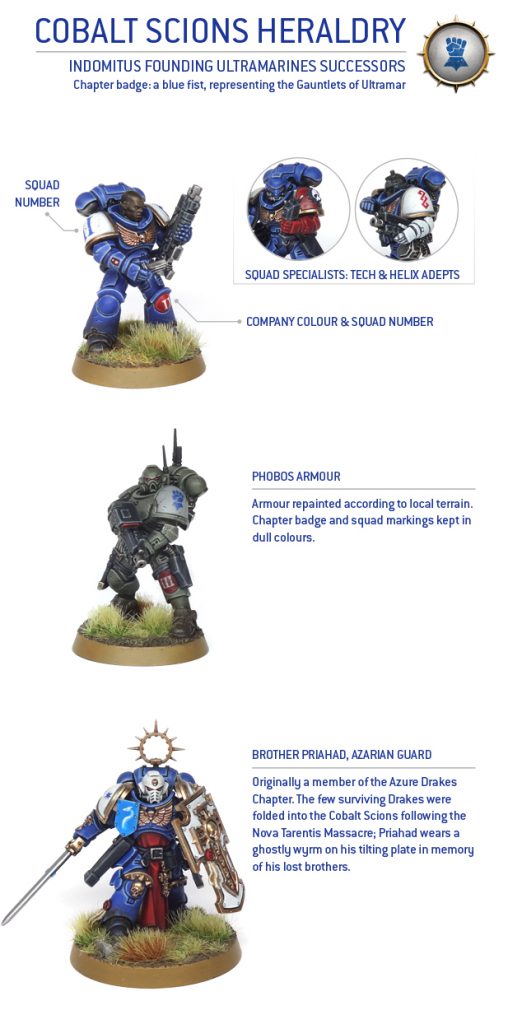
What’s with the squad specialists? Those aren’t in the rules
There’s no in-game effect, it just adds characterful variety to what is otherwise ten bolter boys. Besides, one apothecary per company is nowhere near enough medics, so I figure there have to be junior people who can do the basics.
Individual unit gallery
Black base rims! Wait, no, brown base rims!
The eagle-eyed (read: not blind) among you will note the inconsistency of base rims in the following photos. That’s because I changed my mind some way into the project, but many of these photos were taken before that point. Why the change? Because black rims look nice in a cabinet, but I find they draw the eye and distract from the model when they’re on a table. You see a bunch of black circles before you see the army. Your mileage, of course, may vary.
Captain Lucullus
The stock primaris captain comes with the option to either point angrily or wave a sword around while holding his bolter at an awkward angle. I wanted something more imperious. Kitbashing with the Ultramarines chapter upgrade gave me his crest and his sword (a parting gift from his original chapter). The arms are from the intercessor kit, and let me adjust the pose so that I could get that ‘standing back and surveying’ energy.
I also removed the bling thing swinging between his legs like the 24-karat wang of justice. A little green stuff was needed to smooth the dick curtain, but I prefer this slightly more plain look.

Chapter Master Drusus
I never planned to do a second captain. The army’s meant to be focused on the 3rd company only. But this thiccboy was too pretty to ignore, so he’s my chapter master instead. I gave him the excellently sculpted head from the new primaris ancient, since it suits the character more, and removed the servo skull as it just made the silhouette messy. I also magnetised the off hand weapons, because adaptability is victory.
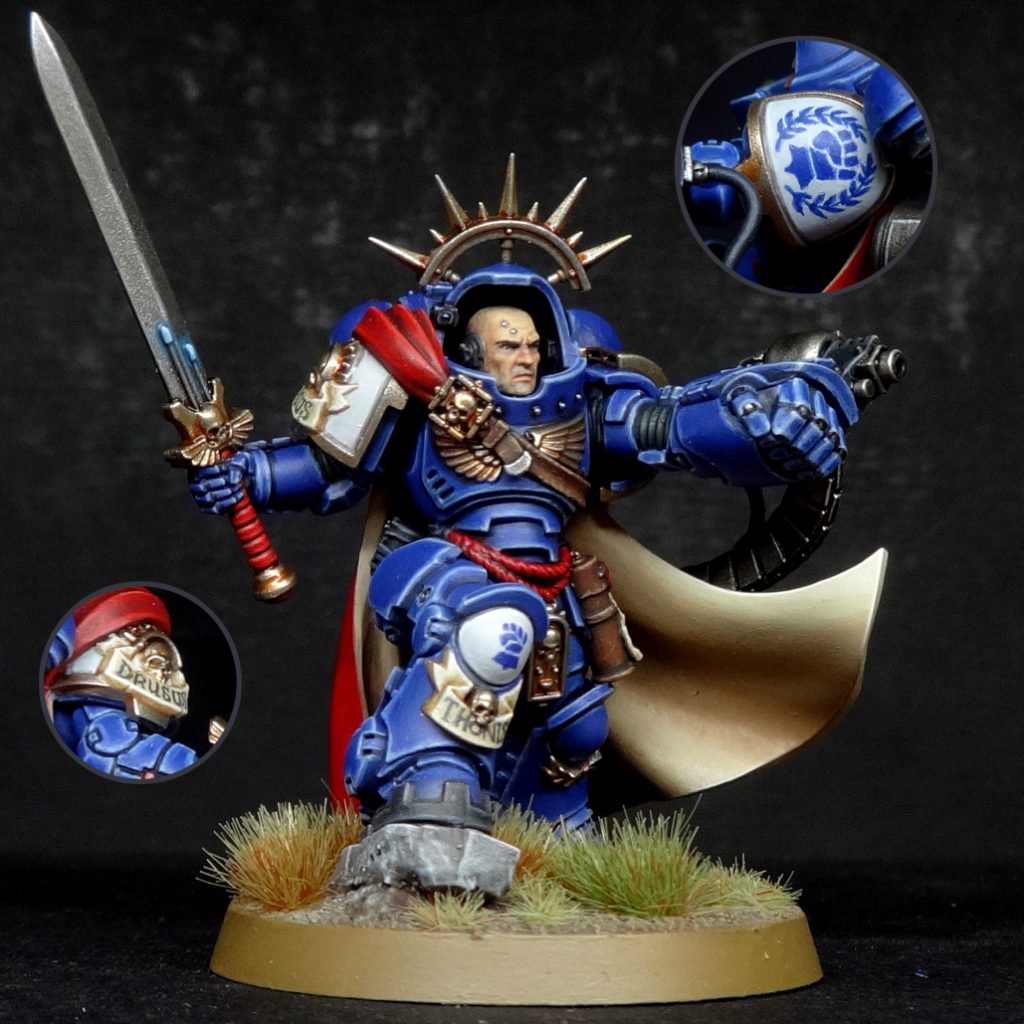
Apothecary Eudemus
I liked the idea of an apothecary not holding any guns at all. A little slicing and dicing and kitbashing on the arms was all that was really needed here, and was definitely worth it for the novelty of a 40K mini that isn’t holding a weapon.
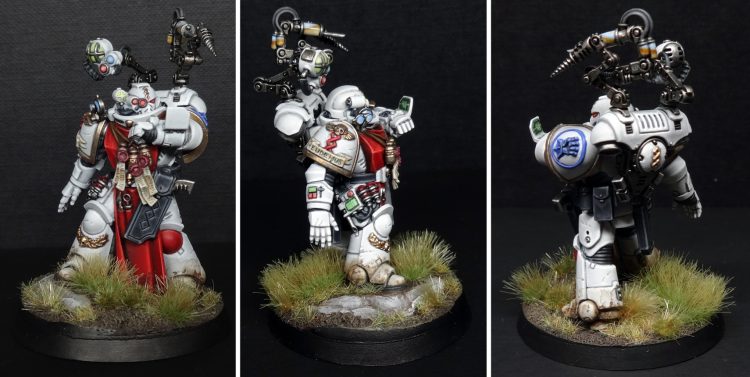
Chaplain Verus & Lieutenant Nerva
These are just headswaps, but for the lieutenant in particular it’s a VITAL change from one stern-looking white dude to a slightly different flavour of stern-looking white dude.
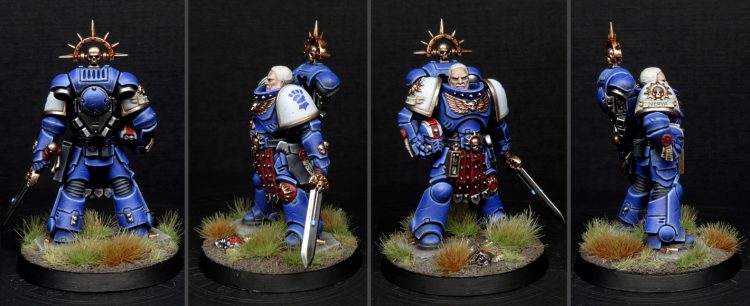
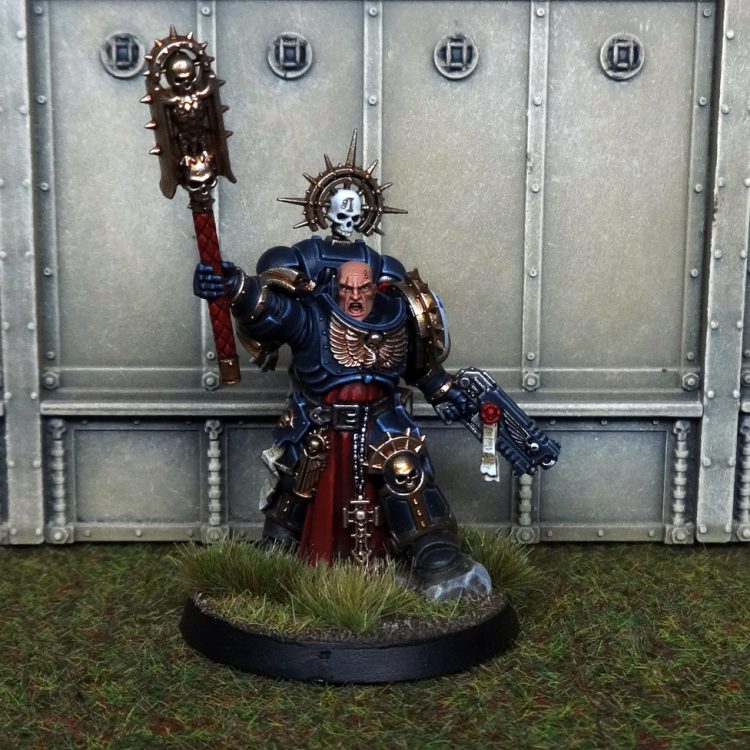
Ancient Aulus
No conversion work here, but I had fun with the freehand painting elements (including a somewhat optimistic crack at painting the Scions’ homeworld Thonis onto the banner).
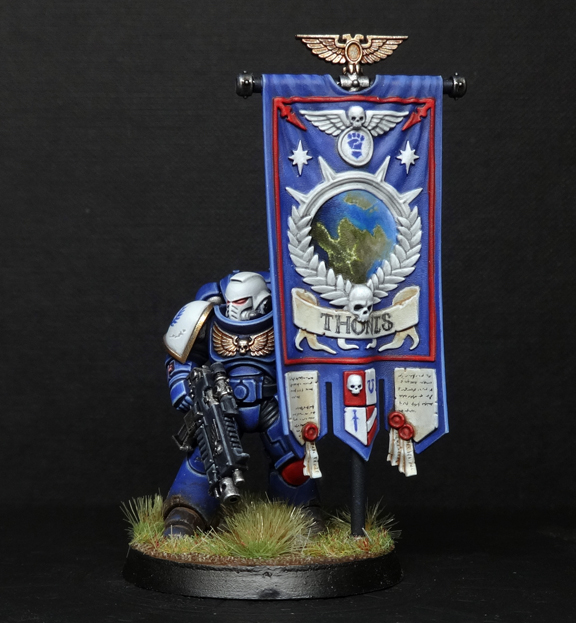
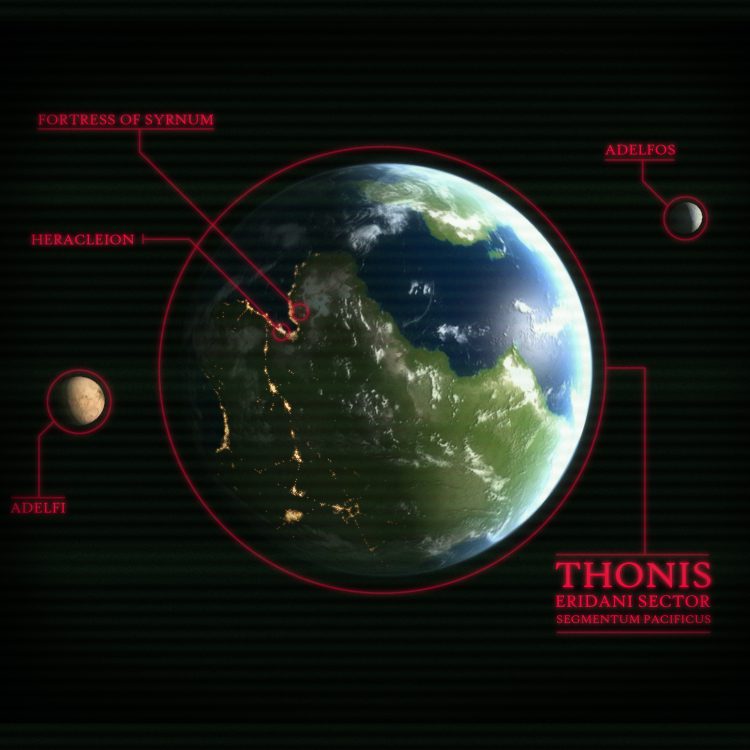
Full Command Squad
The point of this whole command squad was to give off a consistent vibe as a group. The fact that NONE of them are in action poses is deliberate; it’s got that regal patrician standoffishness that’ll exasperate the crap out of, say, Black Templars and the like.
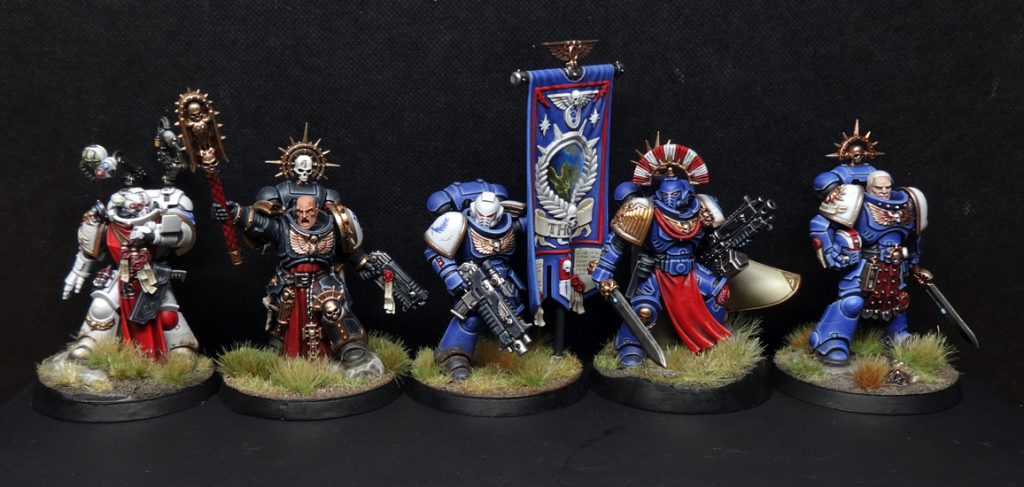
Squad Cassander
This is the fairly widespread kitbash of regular intercessors and assault intercessors, but it helps convey Segeant Cassander’s enthusiasm for getting after it.
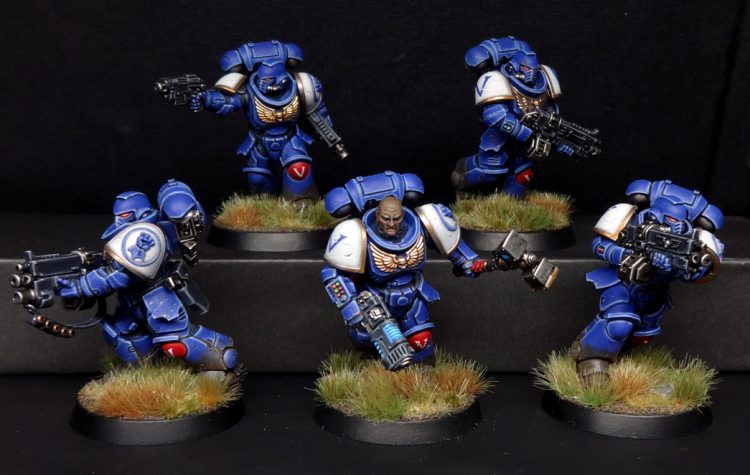
Boriel’s Wrath
I find repulsor chassis turrets a tad busy so I stuck the grenade boxes on the wee storm bolter turrets, closed the hatches, and consequently treat the turret’s turrets as mystery fun boxes of many dice. I much prefer the more minimalist look to the original gun porcupine.
Sidenote on the painting: to evoke the Scions’ enthusiasm for venerating Imperial heroes, the tank is named for a Dark Angels biker who heroically aided some beleaguered Scions. His final deeds are written on the tank’s stern, along with his chapter badge, while his name is freehanded on the bow.

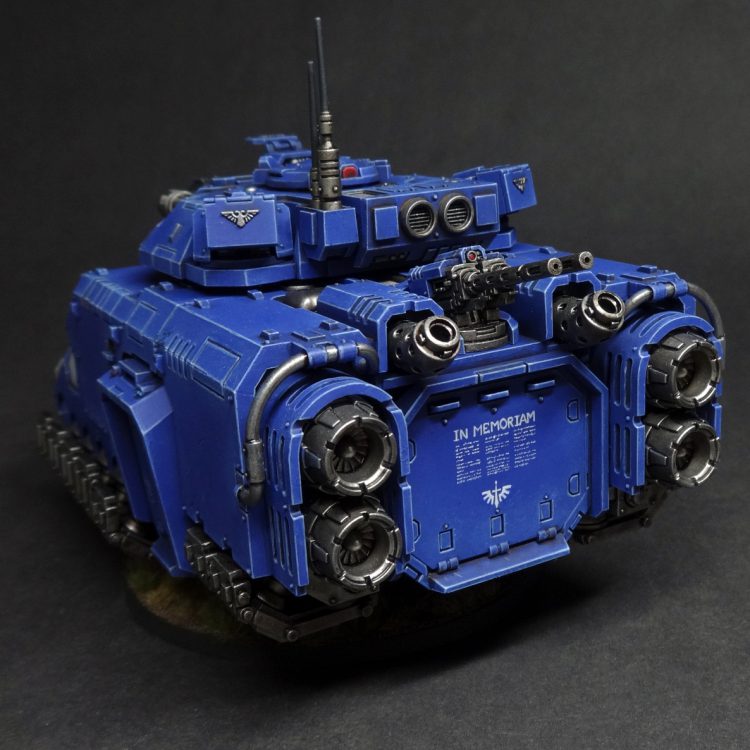
Impulsor/Lancer
This is only in the ‘conversions’ section because I wanted to give a shout out to the sculptor for making it possible for the turret assembly to just sit on the back of the impulsor chassis without needing glue or magnets. Extremely cool, 5/5 would high five.
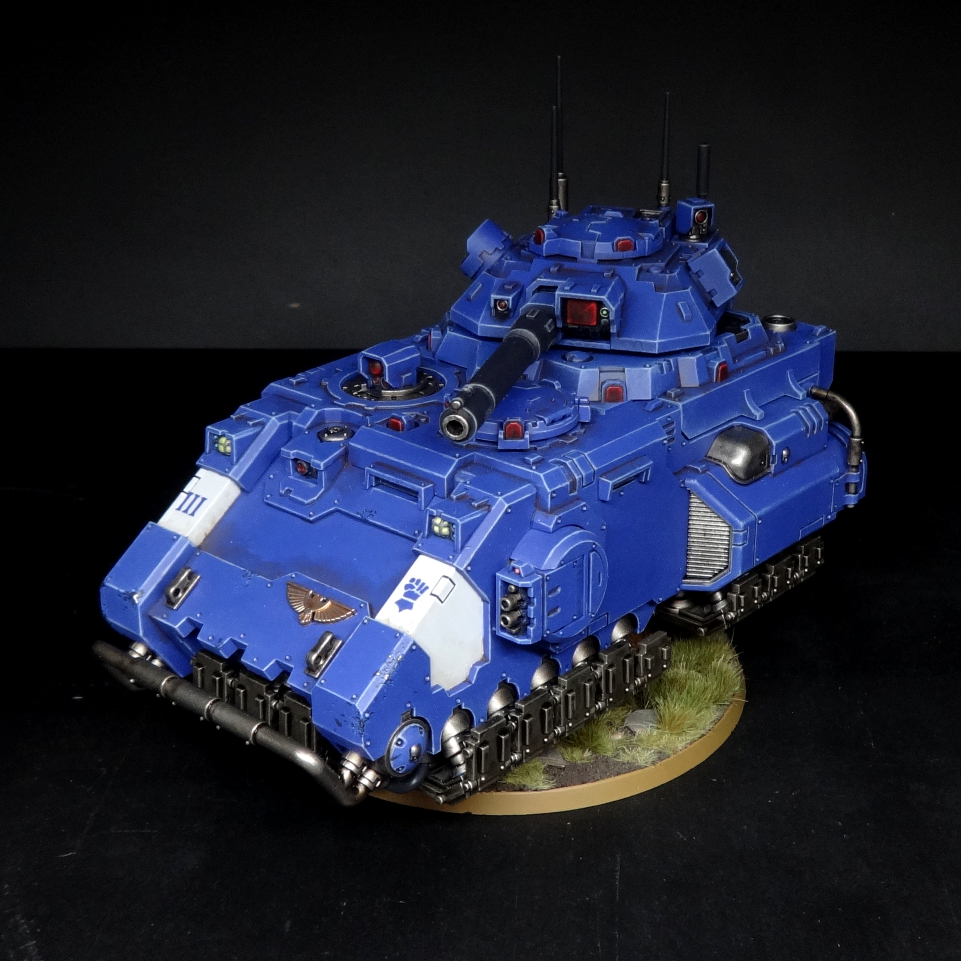
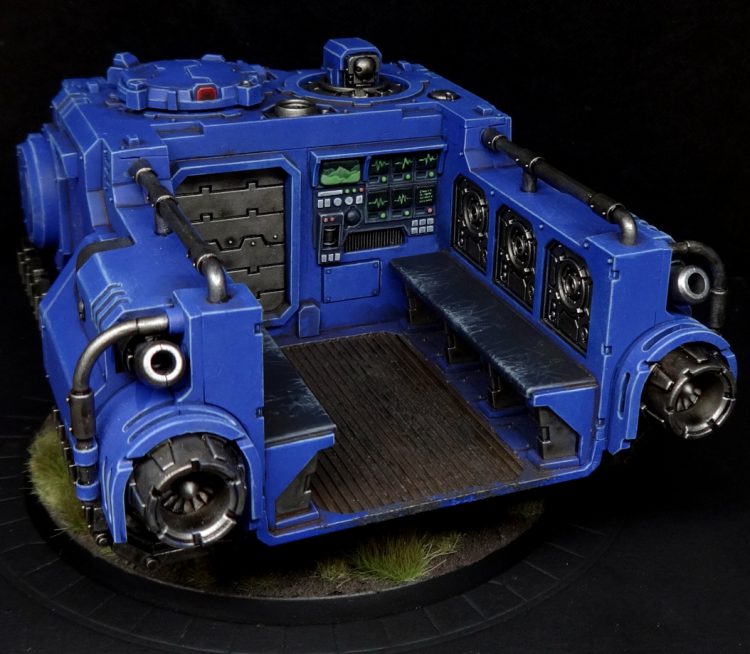
Servo turrets
One techmarine per anti-gravity turret seems excessive, and it’s actually pretty straightforward to chop these things up and turn them into an automated turret. This, in turn, is cool for setting up base defences and other stuff. Turns it from a crazy waste of a techmarine’s expertise to “I’m managing an entire battery of guns from the comfort of a hovering lay-z-boy.”

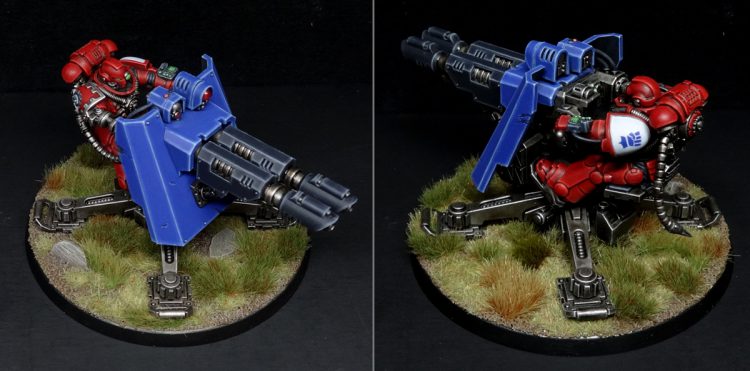
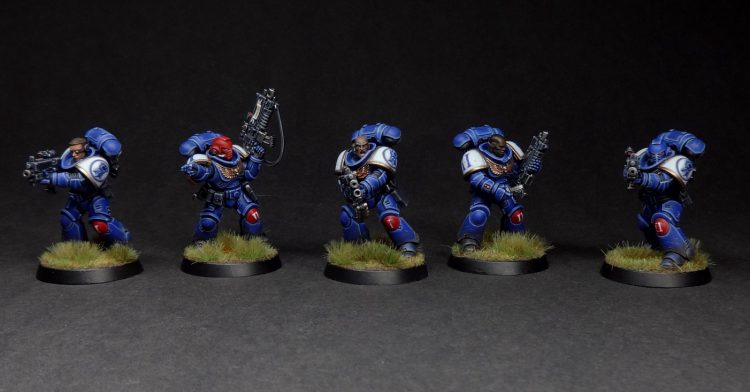
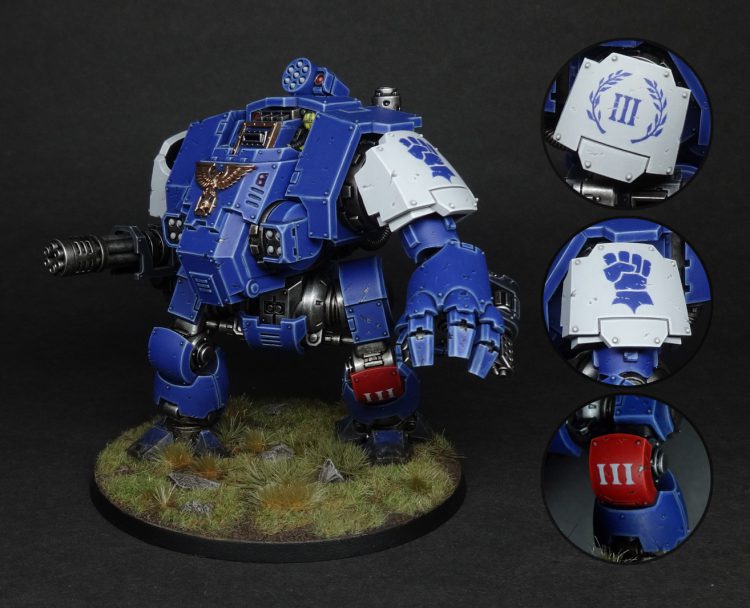


The Future
Since the army is well past the basic functionality stage, I can paint according to whim rather than obligation. The army could do with some fast attack options, and it’d be fun to add more Phobos units. Honestly there’s loads that could be added, even just sticking to Primaris units. Do you have any questions or comments about this army, or triplicate, or standing on a hero rock and delivering inspirational oration while the wind stirs your cape? Then drop a note in the comments below or email us at contact@goonhammer.com.
